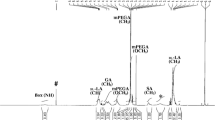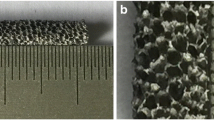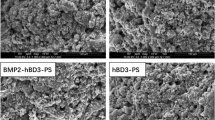Summary
In this study, the bioactivity of a novel BMP2-derived oligopeptide P24 was investigated by using the model of rabbit femoral defect after loaded in the biodegradable poly (lactic acid / glycolic acid / asparagic acid-co-polyethylene glycol) (PLGA-[ASP-PEG]). A 1.5-cm unilateral segmental bone defect was created in the left femoral diaphysis in each of the 30 new zealand white rabbits. The defects of 18 legs filled with BMP2-derived peptide P24 combined with PLGA-[ASP-PEG] scaffold serves as the experimental group, and the defects in the rest 12 rabbits filled with (PLGA-[ASP-PEG]) without P24 as control group. The bone-repairing capability in the target region of the two group was grossly, radiologically, histopathologically and biomechanically evaluated 4, 8 and 12 weeks after the operation. Our results showed that in each group, primary healing of incision was achieved in the two groups. Radiographically, in experimental group, defects were filled with induced callus within 8 weeks, and a cortical bone-like structure was observed in some animals at the 12th week. According to the standardized stage of bone defect repair, 9 (64.28%) achieved grade-4 healing. In contrast, little bone formation was seen in the defects even 12 weeks after the operation, and 5 (62.50%) had grade 0 healing in this group. Histologically, tissue engineering material was mostly absorbed and cartilage was found around implants in the experimental group at the 4th week; 8 weeks after operation, the engineering material was completely absorbed, and formation of woven bone was observed and typical trabecular bone structure could be seen. In control group, 8 weeks after operation, the defect was filled with fibrous tissues, and no bone-like structure was observed. Statistical analysis showed very significant difference in biomechanical indicators between the two groups (P<0.05). It is concluded that new oligopeptide P24 can induce excellent bone regeneration and promote bone repair.
Similar content being viewed by others
References
Murakami N, Saito N, Horiuchi H et al. Repair of segmental defects in rabbit humeri with titanium fiber mesh cylinders containing recombinant human bone morphogenetic protein-2 and a synthetic polymer. J Biomed Mater Res, 2002,62(2):169–174
Terada S, Sato M, Sevy A et al. Tissue engineering in the twenty-first century. Yonsei Med J, 2000,6(41):685–691
Cheng H, Jiang W, Phillips F et al. Osteogenic activity of the fourteen type of human bone morphogenic proteins( BMPs). J Bone Joint Surg Am, 2004,86-A(1): 141–147
Boden S D. The ABCs of BMPs. Orthop Nurs, 2005,24(1):49–52
Chen D, Zhao M, Mundy G R. Bone morphogenetic proteins. Growth Factors, 2004,22(4):233–241
Groeneveld E H, Burger E H. Bone morphogenetic proteins in human bone regeneration. Eur J Endocrinol, 2000,142(1):9–21
Zhao J, Quan D P, Liao K R et al. PLGA-(L-Asp-alt-diol)x-PLGAs with Different Contents of Pendant Amino Groups: Synthesis and Characterization. Macromol Biosci (Chinese), 2005,5(7):636–643
Urist M R. Bone: formation by autoinduction. 1965. Clin Orthop Relat Res, 2002,(395):4–10
Geiger M, Li R H, Friess W. Collagen sponges for bone regeneration with rhBMP-2. Adv Drug Deliv Rev, 2003, 55(12):1613–1629
Wozney J M, Seeherman H J. Protein-based tissue engineering in bone and cartilage repair. Curr Opin Biotechnol, 2004,15(5):392–398
Yuan Q, Guo X D, Zheng Q X et al. Bioinspired growth of hydroxyapatite nanocrystals on PLGA-(PEG-ASP)n scaffolds modified with oligopeptide derived from BMP-2. Key Engin Mater, 2007,334:1261–1264
Kirsch T, Nickel J, Sebald W. BMP-2 antagonists emerge from alterations in the low-affinity binding epitope for receptor Bmpr II. EMBO J, 2000,19(4):3314–3324
Knaus P, Sebald W. Cooperativity of binding epitopes and receptor chains in the BMP/TGFbeta superfamily. Biol Chem, 2001,382(8):1189–1195
Kirsch T, Sebald W, Dreyer M K. Crystal structure of the BMP-2-BRIA ectodomain complex. Nat Struct Biol, 2000, 7(6):492–496
Saitoa A, Suzuki Y, Ogataa S et al. Activation of osteo-progenitor cells by a novel synthetic peptide derived from the bone morphogenetic protein-2 knuckle epitope. Biochim Biophys Acta, 2003,1651(1–2):60–67
Suzuki Y, Tanihara M, Suziki K et al. Alginate hydrogel linked with synthetic oligopeptidederived from BMP-2 allows ectopic osteoinduction in vivo. J Biomed Mater Res, 2000,50(3):405–409
Atsuhiro S, Yoshihisa S, Shinichi O et al. Prolonged ectopic calcification induced by BMP-2-derived synthetic peptide. J Biomed Mater Res, 2004,70(1):115–121
Atsuhiro S, Yoshihisa S, Shin-Ichi O et al. Accelerated bone repair with the use of a synthetic BMP-2-derived peptide and bone-marrow stromal cells. J Biomed Mater Res, 2005,72(1):77–82
Karp J M, Shoichet M S, Davies J E. Bone formation on two-dimensional poly(DL-lactide-co-glycolide) (PLGA) films and three-dimensional PLGA tissue engineering scaffolds in vitro. J Biomed Mater Res, 2003,64(2): 388–396
Lin C C, Co C C, Ho C C. Micropatterning proteins and cells on polylactic acid and poly(lactide-co-glycolide). Biomaterials, 2005,26(17):3655–3662
Wang X Y, Liao K R, Quan D P et al. Bulk ring-opening polymerization of lactides initiated by ferric alkoxides. Macromolecules (Chinese), 2005,38,4611–4617
Hao J, Zheng Q X, Guo X D et al. Preparation and Cell Adhesion of Tri-Block Polymer Scaffolds in Bone Tissue Engineering. Chin J Biomedical Eng (Chinese), 2005, 24(2):129–133
Liu G H, Guo X D, Zheng Q X et al. Preparation and features of Poly(1actic acid-co-glycolic acid)biomimetic biodegradable polymer scaffolds. Chin J Exp Surg (Chinese), 2004,21(4),461–463
Duan Z X, Zheng Q X, Guo X D et al. Experimental Research on ectopic Osteogenesis of BMP2-deriived Peptide P24 with PLGA Copolymers. J Huazhong Univ Sci Technol [Med Sci], 2007,27(2):179–182
Author information
Authors and Affiliations
Additional information
Zhixia DUAN, female, born in 1967, Associate Professor
This work was supported by grants from the National Natural Sciences Foundation of China (Nos. 30470483, 30200063, 30170270) and a Program for New Century Excellent Talents (NCET) in University from the Ministry of Education of China (No. 20045006071-10).
Rights and permissions
About this article
Cite this article
Duan, Z., Zheng, Q., Guo, X. et al. Repair of rabbit femoral defects with a novel BMP2-derived oligopeptide P24. J. Huazhong Univ. Sci. Technol. [Med. Sci.] 28, 426–430 (2008). https://doi.org/10.1007/s11596-008-0411-3
Received:
Published:
Issue Date:
DOI: https://doi.org/10.1007/s11596-008-0411-3




